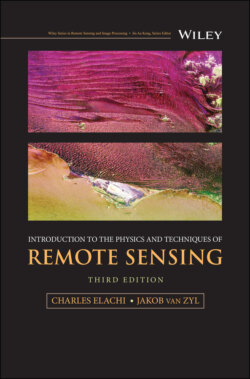Читать книгу Introduction to the Physics and Techniques of Remote Sensing - Jakob J. van Zyl - Страница 16
1.4 Transmission Through the Earth and Planetary Atmospheres
ОглавлениеThe presence of an atmosphere puts limitations on the spectral regions that can be used to observe the underlying surface. This is a result of wave interactions with atmospheric and ionospheric constituents leading to absorption or scattering in specific spectral regions (Figure 1.19).
Figure 1.18 Comparison of temperature profiles acquired with a microwave sounder (NEMS) and radiosonde. The spatial and temporal differences, Δs and Δt, between the two measurements are indicated.
Source: Waters et al. (1975). © 1975, American Meteorological Society.
Figure 1.19 Generalized absorption spectrum of the Earth’s atmosphere at zenith. The curve shows the total atmospheric transmission.
At radio frequencies below 10 MHz, the Earth’s ionosphere blocks any transmission to or from the surface. In the rest of the radio frequency region, up to the low microwave (10 GHz), the atmosphere is effectively transparent. In the rest of the microwave region, there are a number of strong absorption bands, mainly associated with water vapor and oxygen.
In the submillimeter and far‐infrared region, the atmosphere is almost completely opaque, and the surface is invisible. This opacity is due mainly to the presence of absorption spectral bands associated with the atmospheric constituents. This makes the spectral region most appropriate for atmospheric remote sensing.
The opacity of the atmosphere in the visible and near infrared is high in selected bands where the high absorption coefficients are due to a variety of electronic and vibrational processes mainly related to the water vapor and carbon dioxide molecules. In the ultraviolet, the opacity is mainly due to the ozone layer in the upper atmosphere.
The presence of clouds leads to additional opacity due to absorption and scattering by cloud drops. This limits the observation capabilities in the visible, infrared, and submillimeter regions. In the microwave and radio frequency regions, clouds are basically transparent.
In the case of the other planets, more extreme conditions are encountered. In the case of Mercury, the Moon, asteroids, comets, and Pluto, no significant atmosphere exists, and the whole electromagnetic spectrum can be used for surface observation. In the case of Venus and Titan, the continuous and complete cloud, or haze, coverage limits surface observation to the longer wavelength regions, particularly radio frequency and microwave bands. In the case of Mars, the tenuous atmosphere is essentially transparent across the spectrum even though a number of absorption bands are present. In the case of the giant planets, the upper atmosphere is essentially all that can be observed and studied remotely with some deeper access from emitted microwave radiation.
